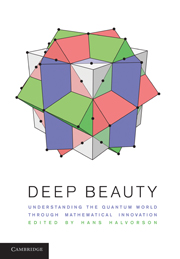Book contents
- Frontmatter
- Contents
- Contributors
- Preface
- Acknowledgments
- Introduction
- I Beyond the Hilbert Space Formalism: Category Theory
- 1 A Prehistory of n-Categorical Physics
- 2 A Universe of Processes and Some of Its Guises
- 3 Topos Methods in the Foundations of Physics
- 4 The Physical Interpretation of Daseinisation
- 5 Classical and Quantum Observables
- 6 Bohrification
- II Beyond the Hilbert Space Formalism: Operator Algebras
- III Behind the Hilbert Space Formalism
- Index
1 - A Prehistory of n-Categorical Physics
from I - Beyond the Hilbert Space Formalism: Category Theory
Published online by Cambridge University Press: 01 June 2011
- Frontmatter
- Contents
- Contributors
- Preface
- Acknowledgments
- Introduction
- I Beyond the Hilbert Space Formalism: Category Theory
- 1 A Prehistory of n-Categorical Physics
- 2 A Universe of Processes and Some of Its Guises
- 3 Topos Methods in the Foundations of Physics
- 4 The Physical Interpretation of Daseinisation
- 5 Classical and Quantum Observables
- 6 Bohrification
- II Beyond the Hilbert Space Formalism: Operator Algebras
- III Behind the Hilbert Space Formalism
- Index
Summary
Introduction
This chapter is a highly subjective chronology describing how physicists have begun to use ideas from n-category theory in their work, often without making this explicit. Somewhat arbitrarily, we start around the discovery of relativity and quantum mechanics and lead up to conformal field theory and topological field theory. In parallel, we trace a bit of the history of n-categories, from Eilenberg and Mac Lane's introduction of categories, to later work on monoidal and braided monoidal categories, to Grothendieck's dreams involving ∞-categories, and subsequent attempts to realize this dream. Our chronology ends at the dawn of the twenty-first century; since then, developments have been coming so thick and fast that we have not had time to put them in proper perspective.
We call this chapter a “prehistory” because n-categories and their applications to physics are still in their infancy. We call it “a” prehistory because it represents just one view of a multifaceted subject; many other such stories can and should be told. Ross Street's An Australian Conspectus of Higher Categories [228] is a good example in that it overlaps with ours, but only slightly. There are many aspects of n-categorical physics that our chronology fails to mention, or touches on very briefly, and other stories could redress these deficiencies. It would also be good to have a story of n-categories that focus on algebraic topology, one that focuses on algebraic geometry, and one that focuses on logic.
- Type
- Chapter
- Information
- Deep BeautyUnderstanding the Quantum World through Mathematical Innovation, pp. 13 - 128Publisher: Cambridge University PressPrint publication year: 2011
- 8
- Cited by



